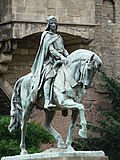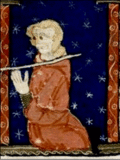| Ruler | Born | Reign | Death | Ruling part | Consort | Notes |
|---|
Ramon Berenguer I the Great
El Gran
|  | 11 November 1082
Rodez
Son of Ramon Berenguer II
and Mafalda of Apulia-Calabria | 1112 –19 July 1131 | 19 July 1131
Barcelona
aged 48 | County of Provence | María Rodríguez de Vivarbr/>1103
two children
Almodis de Mortain
1106
no children
Douce I, Countess of Provence
3 February 1112
Arles
seven children | His last marriage with the heiress of Provence brought it under Barcelona domain. His reign saw a proliferation of Provençal culture in Catalonia. |
| Alfonso Jordan |  | 1103
Tripoli
Son of Count Raymond IV of Toulouse and Elvira of Castile | 1125 - 16 August 1148 | 16 August 1148
Caesarea
aged 44–45 | Margraviate of Provence | Faydite d'Uzès
c.1125
four children | Also Count of Toulouse. Obtained half of Provence by the division agreement of 1125. |
| William III | | c.1080
Son of Ermengol IV, Count of Urgell and Adelaide, Countess of Forcalquier | 1129 –7 October 1129 | 7 October 1129
Avignon
aged 48–49 | County of Forcalquier | Gersende of Albon
c.1080
two children | Came from the Urgell branch of the House of Barcelona. Inherited the neighbouring County of Forcalquier. |
| Guigues | | c.1090?
First son of William III of Forcalquier and Gersende of Albon | 7 October 1129 –1149 | 1149
aged 58–59 | County of Forcalquier | Unknown
one child | His child probably predeceased him, as he was succeeded by his brother. |
| Regency of Ramon Berenguer IV, Count of Barcelona (1144–1157) | In August 1161, he travelled to Turin with his uncle to obtain confirmation of his countship in Provence from the Emperor Frederick I, for Provence was legally a fief of the Holy Roman Empire. |
| Ramon Berenguer II | | c.1135
Son of Berenguer Ramon I and Beatrice of Melgueil | March 1144 – March 1166 | March 1166
Nice
aged 30–31 | County of Provence | Richeza of Poland
17 November 1161
one child |
| Raymond I | | 1134
Tripoli
Son of Alfonso Jordan and Faydite d'Uzès | 16 August 1148 - December 1194 | December 1194
Nîmes
aged 59–60 | Margraviate of Provence | Constance of France
c.1154
(annulled 1166)
five children | Also Count of Toulouse as Raymond V. |
| Bertrand I | | 1104
Second son of William III of Forcalquier and Gersende of Albon | 1149 –1151 | 1151
aged 46–47 | County of Forcalquier | Josserande de la Flotte
1130
three children | |
| Bertrand II | | c.1130?
First son of Bertrand I and Josserande de la Flotte | 1151 –13 May 1207 | 13 May 1207
aged 76–77 | County of Forcalquier | Cecilia of Béziers
two children | Left no male heirs, and was succeeded by his brother. |
| Regency of Richeza of Poland (1166-1167) | She ruled a few months, as her half brother-in-law, Alfonso II of Aragon, claimed Provence for himself on the basis of the imperial enfeoffment of 1162. |
| Douce II | | c.1162
Daughter of Ramon Berenguer II and Richeza of Poland | March 1166 – 1167 | 1172
Nice
aged 9–10 | County of Provence | Unmarried |
Alphonse I the Troubadour
El Trobador
|  | 1-25 March 1157
Huesca
Son of Ramon Berenguer IV and Petronilla | 1167 – 1173 | 25 April 1196
Perpignan
aged 44 | County of Provence | marriage agreement with
Mafalda of Portugal 1159-1162, not fulfilled
Sancha of Castile
18 January 1174
Zaragoza
seven children | Formal union of the Kingdom of Aragon and Barcelona. Alfonso also reunited various feudal dependencies. In August 1161, he travelled to Turin with his uncle obtain the confirmation of his countship in Provence from the Emperor Frederick I, for Provence was legally a fief of the Holy Roman Empire. In 1173, he gave the county to his younger brother Ramon Berenguer. However, he kept the title until his death in 1196. |
Peter
Ramon Berenguer III |  | c.1158
Son of Count Ramon Berenguer IV of Barcelona and Petronilla of Aragon | 1173–5 April 1181 | 5 April 1181
Montpellier
aged 22–23 | County of Provence | Unmarried | Abdicated of Cerdanya to his brother Sancho. In 1173, assuming the county of Provence, changed his name to Ramon Berenguer. In 1176, he joined Sancho in conquering Nice from Genoa. He was assassinated. |
| Sancho |  | c.1161
Son of Count Ramon Berenguer IV of Barcelona and Petronilla of Aragon | 5 April 1181 – 1185 | 1223
Montpellier
aged 61–62 | County of Provence | Ermesinde of Rocabertí
1184
one child
Sancha Núñez de Lara
1185
one child | Received from his brother the counties of Cerdanya and Roussillon, and in 1181, received also the County of Roussillon, in the sequence of the same brother's death. In 1184, Sancho signed a treaty of alliance with the count of Forcalquier, the count of Toulouse and the Republic of Genoa agreeing to oppose the king of Aragon's efforts to dominate Genoa and to take the city of Marseille from him. Abdicated from Provence in 1185, but ruled in Cerdanya-Roussillon until his death. |
| Alphonse II |  | 1180
Barcelona
Son of Alfonso I and Sancha of Castile | 1185 –2 February 1209 | 2 February 1209
Palermo
aged 28–29 | County of Provence | Garsenda, Countess of Forcalquier
July 1193
Aix-en-Provence
one child | His reign was marked by his conflicts with the count of Forcalquier, to whose granddaughter he was married. |
| Raymond II |  | 27 October 1156
Saint-Gilles, Gard
Son of Raymond I and Constance of France | December 1194 - 1 August 1222 | 1 August 1222
Toulouse
aged 65 | Margraviate of Provence | Ermessende of Pelet
1172
no children
Beatrice of Béziers
after 1176
(annulled 1189)
one child
Joan of England
October 1196
Rouen
two children
A daughter of Isaac Komnenos of Cyprus
c.1200
(annulled 1202)
no children
Eleanor of Aragon
January 1204
Perpignan
no children | Also Count of Toulouse as Raymond VI. Allied with the Cathars, like many of the neighbouring Languedoc states, his domains in Toulouse were challenged by the Albigensian Crusade between 1215 and 1218. |
| William IV | | c.1130
Second son of Bertrand I and Josserande de la Flotte | 13 May 1207 –7 October 1209 | 7 October 1209
aged 78–79 | County of Forcalquier | Adelaide of Béziers
one child | Left a daughter, Garsenda, who predeceased him; he was succeeded by his granddaughter, also named Garsenda. |
| Garsenda |  | c.1180
Daughter of Rainou of Sabran and Garsenda of Forcalquier | 7 October 1209 –1222 | 1242
aged 60–61 | County of Forcalquier
( House of Sabran ) | Alfonso II, Count of Provence
July 1193
Aix-en-Provence
one child | In 1222, she abdicated for her son, and Forcalquier was absorbed by Provence. |
| Forcalquier annexed to Provence |
| Regency of Garsenda, Countess of Forcalquier (1209–1220) | Supporter of the Provençal lyric and culture and the Albigensian Crusade. He also helped his father-in-law in his conflict with Turin and Guigues VI of Viennois. His surviving four daughters all married kings, causing a dispute about his succession. |
| Ramon Berenguer IV |  | 1198
Son of Alfonso II and Garsenda, Countess of Forcalquier | February 1209 –19 August 1245 | 19 August 1245
Aix-en-Provence
aged 46–47 | County of Provence | Beatrice of Savoy
5 June 1219
Aix-en-Provence
six children |
| Raymond VII |  | July 1197
Beaucaire, Gard
Son of Raymond II and Joan of England | 1 August 1222 - 27 September 1249 | 27 September 1249
Toulouse
aged 52 | Margraviate of Provence | Sancha of Aragon
March 1211
(annulled 1241)
one child
Margaret of Lusignan
1243
(annulled 1245)
no children | Also Count of Toulouse as Raymond VII. Took Carcassonne with Count Roger-Bernard III of Foix, in the Albigensian Crusade. |
| Beatrice |  | 1229
Daughter of Ramon Berenguer IV and Beatrice of Savoy | 19 August 1245 –23 September 1267 | 23 September 1267
Nocera Inferiore
aged 37–38 | County of Provence | Charles I, King of Sicily
31 January 1246
Aix-en-Provence
seven children | Her inheritance caused tense relations with her sisters; Her husband installed his French court in Provence and, after her death, inherited the county. |
| Joanna |  | c.1220
Toulouse
Daughter of Raymond VII and Sancha of Aragon | 27 September 1249 - 25 August 1271 | 25 August 1271
Siena
aged 50–51 | Margraviate of Provence | Alphonse of France
c.1237
Toulouse
no children | The war between Louis VIII of France and Languedoc region ended with the Treaty of Meaux (1229), determining the wedding of Joan, the heiress of Toulouse, with Alphonse, prince of France. The lack of descendance of the couple determined the annexation of the County of Toulouse, the Duchy of Narbonne, and the Margraviate of Provence to the Crown of France after their deaths. |












